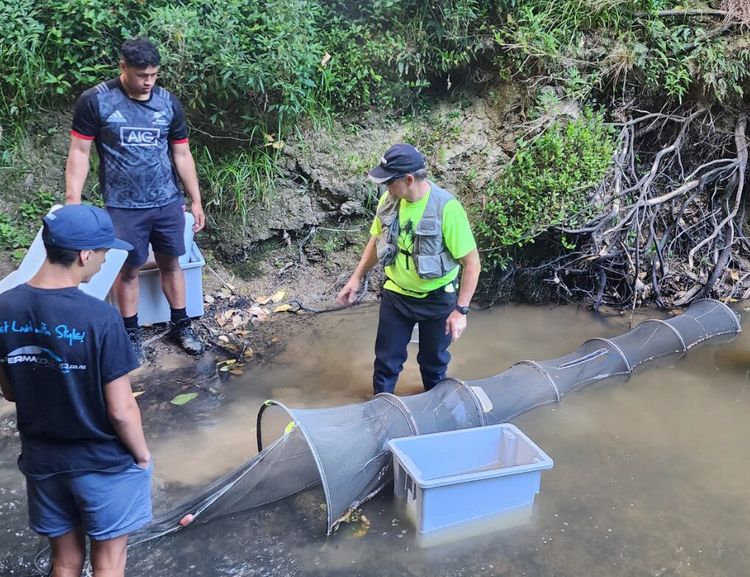New fish rite of passage for Ruakākā - Inside Government NZ

A multi-agency partnership is paving the way for migratory native fish to be able to navigate their way past a Ruakaka weir used for a public water supply.
Northland Regional Councillor, Rick Stolwerk says the Whangarei District Council-owned weir in Flyger Road was identified by NIWA and the NRC as a barrier to migratory fish as part of mahi being undertaken through a Ministry for the Environment funded fish passage project.
“We selected this site as a candidate for remediation and have been working with NIWA and Australasian Fish Passage Services (AFPS) to install a full width rock ramp using locally sourced rock and materials,” said Cr Stolwerk.
“The rock ramp is designed to allow all fish species present to pass over the weir in a wide range of flow conditions.”
Councillor Stolwerk, who represents the NRC’s Coastal South constituency, says the regional council recently led a large-scale fish survey in partnership with Patuharakeke Te Iwi Trust and Department of Conservation (DOC) in a bid to understand how much impact the existing weir is having on fish populations upstream.
In total, 80 Gee minnow traps and 24 fyke nets were deployed in 800 metres of the Ruakaka River.
The survey was supported by multiple Council staff from the Compliance, Biodiversity, Land Management, Monitoring, and Policy teams. Whitebait Connection and DOC also lent their support in the massive task of trap and net retrieval and identification of species.
“We now know some fish, particularly those with climbing abilities, do get past the weir and its associated rock ramp (a previous attempt to improve fish passage) in certain flow conditions,” says project lead for the fish passage project at Council, Jen Mander.
“However, the numbers for fish that do not climb, including smelt, inanga and common bully, are severely reduced upstream compared to the downstream reach.”
The survey data showed 30 times fewer juvenile inanga were caught above the weir than below it (797 below, 27 above).
“This has provided evidence of the severe impact the structure is having on fish migration for these species and has highlighted the need for remediation.”
The survey found inanga, common bullies, redfin bullies, smelt, torrentfish and tuna (eels) of varying sizes.
Councillor Stolwerk says many native fish species are migratory and need to move between the ocean and fresh waters to complete their lifecycle.
“At this time of year, juvenile galaxiid species, collectively known as whitebait, enter our rivers from the ocean to begin their journey upstream to find habitat to grow and mature.”
“Man-made structures such as weirs, culverts, and fords can hinder or completely block fish migration leading to species decline within a catchment.”
Funded by the Ministry for the Environment, NIWA and AFPS are working together to design and install a 25-metre long rock ramp fishway.
AFPS has extensive experience in designing engineered rock ramps, which have proven to be effective for passing small-bodied fish in Australia for over 30 years.
Councillor Stolwerk says New Zealand lags behind Australia in fish passage remediation and urgently needs credible, evidence-based solutions to improve connectivity of its freshwater habitats.
“Once the fish pass is complete, we will be able to compare the data from this survey with future surveys to measure the effectiveness of the remediation,” he said.























































